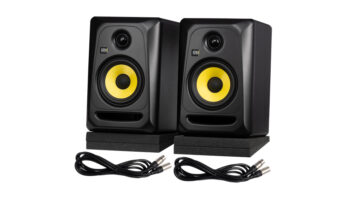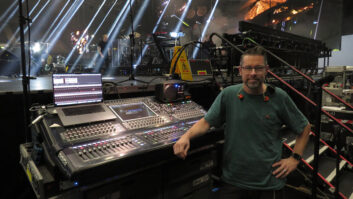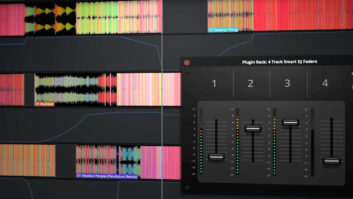
AKG C5
The near-identical look of AKG’s latest series of handheld vocal mics may cause one to assume they are similar, but in fact, these are two completely different products with their own personalities. Both the C 5 condenser and D 5 dynamic models have slightly elongated, 7.3-inch zinc alloy bodies with a gray-blue finish. And other than the model number in small lettering at the base of the mics, the only outward factor that sets these two apart is the word “condenser” on the aluminum band that circles the pop screen on the C 5 model.
UNDER THE HOOD
Unscrew the dent-resistant, spring-steel wire mesh grille, and the changes between the two are striking. The D 5 (also in a version with on/off switch) has a 1-inch diameter diaphragm in a nylon/hardened plastic housing containing a high-output neodymium magnet assembly set into a rubber shock-mounting assembly. The diaphragm uses AKG’s patented Laminate Varimotion technology, a manufacturing technique for varying the diaphragm thickness from 40 microns at the center to 20 microns toward the edge, for better control of capsule resonance. This reduction of unwanted resonances at the source is said to reduce mic’s susceptibility to feedback, especially combined with the supercardioid response of the D 5’s capsule.
The C 5 has a gold-plated, medium-diameter (½-inch) diaphragm set into a machined brass and gold-plated capsule housing that’s said to offer optimum conductivity, with corrosion and humidity resistance. An exceedingly fine layered mesh covers the capsule itself for additional protection, and the assembly is set into an elastomeric surround that delicately floats the capsule, protecting against thumps and handling noise. The C 5 ships with the PB 1000 presence boost adapter installed. The PB 1000 is a plastic cap that surrounds the capsule, with three strategically placed holes acting as a passive acoustical filter. The PB 1000 changes the C 5s upper mid-frequency response, resulting in a 5dB boost centered around 9 kHz for improved vocal intelligibility. When removed (the PB 1000 snaps off easily), the mic has an otherwise mostly flat response, with gently rising high frequencies with two 2dB bumps at 3.5 kHz and 11 kHz.
CENTER STAGE
Overall, both mics have excellent fit and finish and a solid feel, but the use of a standard (rather than inset) screw to keep the XLR in place results in a small bump where the screw extends beyond the body. The mics balance nicely in the hand, although their 12-ounce (×-pound) heft may become noticeable after a long night of handheld use, particularly to the smaller performer.
The internal shock-mounting in the D 5 offers good protection against noise transmission from stage-borne vibration and handling noise. Yet the C 5 goes much further, with enough capsule isolation to ward off anything short of a hit with a baseball bat.

AKG D5
The D 5 is touted for its feedback suppression, and through the combination of the mic’s supercardioid pattern (which remains tight in the critical 2 to 8k Hz band) and the resonance-reduction action of the Laminate Varimotion diaphragm, the D 5 delivers in this regard. In fact, about the only way I could create feedback was to point the capsule directly into the throat of the monitor horn. The C 5 wasn’t quite as dramatic, but with its cardioid pattern staying consistent at nearly any frequency, keeping feedback to a minimum required little more than the usual practice of setting wedges 180 degrees behind the capsule.
I liked the overall sound of the D 5. It has a fairly neutral character with +4dB presence peaks around 5 kHz and 9 kHz. It was fine on male vocals, but seems more suited for female singers who need just a bit of a boost in the upper midrange or high-end for clarity. And if you want gain for miles, the D 5’s feedback suppression and hot neodymium output provides all you need to keep any vocal up front.
The C 5 is quite a different bird. I began with the presence boost cap in place, which makes the C 5 just the thing if you’re looking for an aggressive, in-your-face sound that cuts through the mix of edgy guitars, keys and cymbals. With the PB 1000 in place, the net effect is a crisp top end that’s ideal for male rock vocals and that may be a little too much on an upper soprano voice, although I liked the effect on acoustic guitar in a rock ensemble. Of course, if you don’t like what you hear, simply remove the PB 1000 for a more neutral midrange sound that is similar to that of the D 5.
Both mics have a proximity effect that’s smooth and not overstated, but to take advantage of it, the performer really has to be within two inches from the grille for that extra deep bass fullness. Yet even here, the pop filtering does the job, keeping those problematic “p” and “b” sounds in check.
With the $170 D 5 and $299 C 5, AKG offers two new designs that — in a crowded field of vocal handhelds — provide two interesting new flavors for live performance professionals.
AKG Acoustics, www.akg.com.
George Petersen is Mix‘s executive editor.







